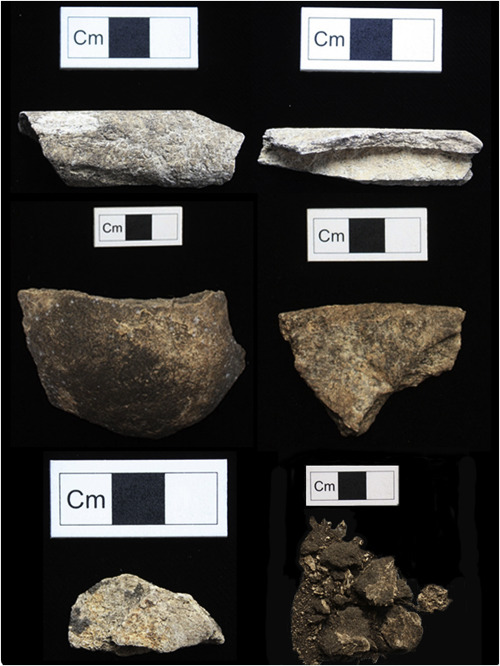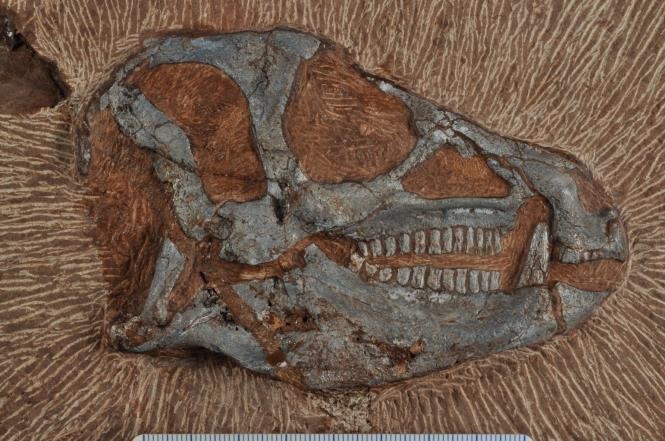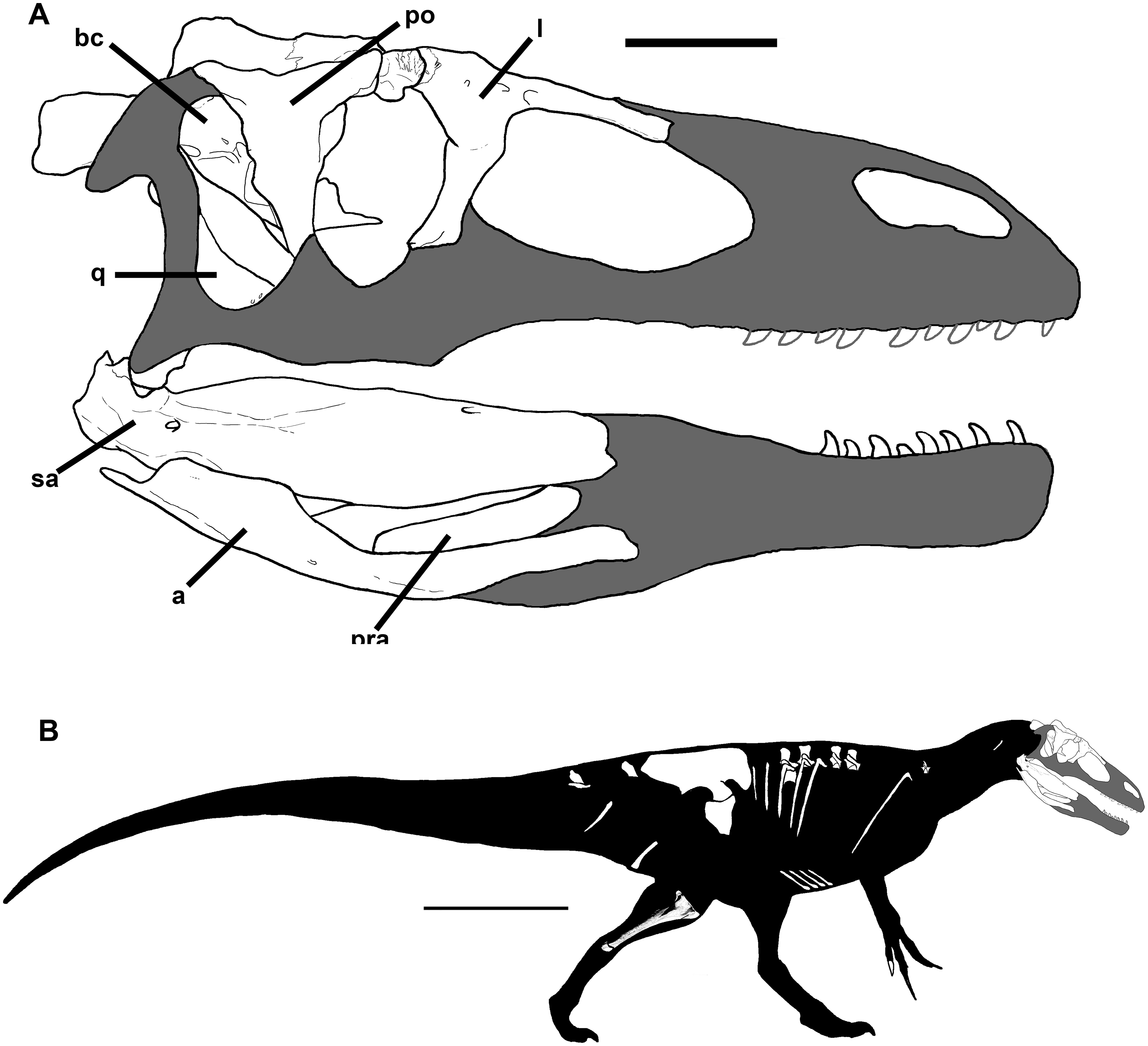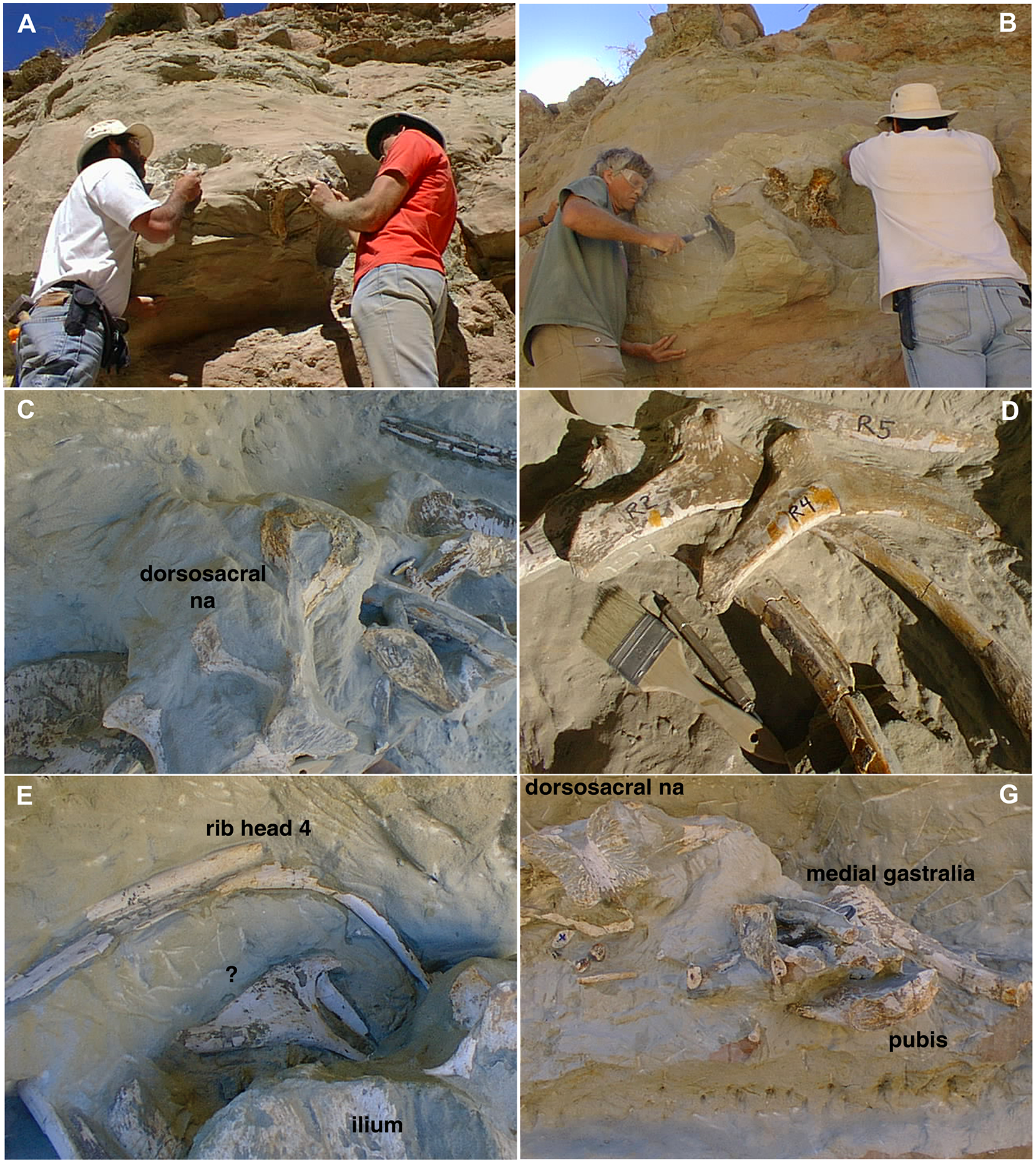WFS News: New light shed on how vertebrates see
 August 8th, 2016
August 8th, 2016  Riffin
Riffin The success of vertebrates is linked to the evolution of a camera-style eye and sophisticated visual system. In the absence of useful data from fossils, scenarios for evolutionary assembly of the vertebrate eye have been based necessarily on evidence from development, molecular genetics and comparative anatomy in living vertebrates. Unfortunately, steps in the transition from a light-sensitive ‘eye spot’ in invertebrate chordates to an image-forming camera-style eye in jawed vertebrates are constrained only by hagfish and lampreys (cyclostomes), which are interpreted to reflect either an intermediate or degenerate condition. Here, we report—based on evidence of size, shape, preservation mode and localized occurrence—the presence of melanosomes (pigment-bearing organelles) in fossil cyclostome eyes. Time of flight secondary ion mass spectrometry analyses reveal secondary ions with a relative intensity characteristic of melanin as revealed through principal components analyses. Our data support the hypotheses that extant hagfish eyes are degenerate, not rudimentary, that cyclostomes are monophyletic, and that the ancestral vertebrate had a functional visual system. We also demonstrate integument pigmentation in fossil lampreys, opening up the exciting possibility of investigating colour patterning in Palaeozoic vertebrates. The examples we report add to the record of melanosome preservation in Carboniferous fossils and attest to surprising durability of melanosomes and biomolecular melanin.
![Fossil cyclostomes from the Mazon Creek Lagerstätte. (a) Myxinikela siroka (PF15373). Scale bar, 5 mm. (b) Mayomyzon pieckoensis (ROMV56800b) showing clearly defined pigmented stripes along the dorsal surface. Scale bar, 5 mm. (c–e) Back-scattered electron (BSE) SEM images of melanosomes present in the eyes of (c) Myxinikela siroka (PF15373), (d) Mayomyzon pieckoensis (LEIUG 123268) and (e) Mayomyzon pieckoensis (ROM56806); note two distinct melanosome morphologies, which is typical of the RPE of fish [12–14]. All scale bars, 5 µm. Not all material preserved as carbon within the fossils shows these textures; for example, in Mayomyzon the oral disc and pharynx comprise sheet-like carbon with associated pyrite. Ellipsoid/oblate textures are not evident in carbon patches beyond the margins of the body in any of the taxa studied. (f) Radial TEM image of the retina of an extant fish (Rhinogobius). Dark pigment granules (melanosomes) are elliptical in the base of the image and spherical at the top of the image. Decay-induced collapse of the RPE would result in a fossilized structure with both elliptical and oblate melanosome morphologies. Scale bar, 5 µm. Image courtesy of Gengo Tanaka. e, eye; ot, oral tentacles; snc, forked subnasal cartilage; b, branchial structure; d, digestive organ; oc, otic capsule, od, oral disc; as, axial structure. (Online version in colour.)](http://www.worldfossilsociety.org/wp-content/uploads/2016/08/151209183454_1_540x360-1-1024x883.jpg)
Fossil cyclostomes from the Mazon Creek Lagerstätte. (a) Myxinikela siroka (PF15373). Scale bar, 5 mm. (b) Mayomyzon pieckoensis (ROMV56800b) showing clearly defined pigmented stripes along the dorsal surface. Scale bar, 5 mm. (c–e) Back-scattered electron (BSE) SEM images of melanosomes present in the eyes of (c) Myxinikela siroka (PF15373), (d) Mayomyzon pieckoensis (LEIUG 123268) and (e) Mayomyzon pieckoensis (ROM56806); note two distinct melanosome morphologies, which is typical of the RPE of fish [12–14]. All scale bars, 5 µm. Not all material preserved as carbon within the fossils shows these textures; for example, in Mayomyzon the oral disc and pharynx comprise sheet-like carbon with associated pyrite. Ellipsoid/oblate textures are not evident in carbon patches beyond the margins of the body in any of the taxa studied. (f) Radial TEM image of the retina of an extant fish (Rhinogobius). Dark pigment granules (melanosomes) are elliptical in the base of the image and spherical at the top of the image. Decay-induced collapse of the RPE would result in a fossilized structure with both elliptical and oblate melanosome morphologies. Scale bar, 5 µm. Image courtesy of Gengo Tanaka. e, eye; ot, oral tentacles; snc, forked subnasal cartilage; b, branchial structure; d, digestive organ; oc, otic capsule, od, oral disc; as, axial structure. (Online version in colour.)
- Sarah E. Gabbott, Philip C. J. Donoghue, Robert S. Sansom, Jakob Vinther, Andrei Dolocan, Mark A. Purnell. Pigmented anatomy in Carboniferous cyclostomes and the evolution of the vertebrate eye.Proceedings of the Royal Society B: Biological Sciences, 2016; 283 (1836): 20161151 DOI: 10.1098/rspb.2016.1151
Key: WFS,World Fossil Society,Riffin T Sajeev,Russel T Sajeev
An analysis on predatory signatures on Miocene oysters Of Crassostrea Sp.from east coast of southern India
 August 4th, 2016
August 4th, 2016  Riffin
Riffin Riffin T Sajeev*
Department of Geology, Periyar University, Salem,INDIA .*riffin@rediffmail.com
The eastern coast lines of southern India are rarely used to study its paleontological importance. Living oysters of Crassostrea Sp. are found throughout these coastal margins. Recent reports indicate the existence of a paleo-estuary dated to the mio-pliocene age, along the valleys of the southern end of Western Ghats. About 70 specimen of Crassostrea Sp. have been sampled from this area of which, almost 80 percent are disarticulated and observed as subjected to the predatory action of ichnotaxa.
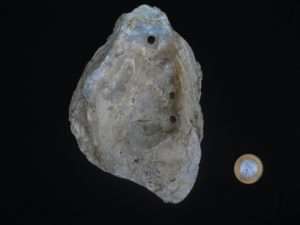
Crassostrea Fossil with action of ichnotaxa. (c) World Fossil Society. Photo Courtesy @Riffin T Sajeev & Russel T Sajeev
All oysters seem to have adapted extremely thick layered calcite shells, which is a remarkable morphological feature. Bore holes and biodegradation are seen in an extreme magnitude. A previous work of the author describes the existence of a giant Paleo-estuary which existed along the eastern coastlines of India during the mio-pliocene age, based on the morphological and taxonomical features of Crassostrea Sp. from the same area. The proposed work is a detailed analysis of the Predatory signatures on shell fragments by ichospecies in the proposed paleo-estuary during the mio-pliocene age.
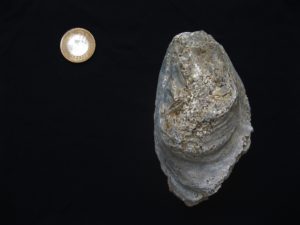
Crassostrea Fossil with action of ichnotaxa. (c) World Fossil Society. Photo Courtesy @ Riffin T Sajeev & Russel T Sajeev
In this study, the author analyzes the nature of the ichnospecies that thrived among these oysters, their threat to the life of oysters and their contribution towards the necessity for an adaptation of a thick layered shell on these oysters. The study proposes to identify each ichnotaxa by analyzing their predatory pattern and the style of biodegradation on the host shells. The study also proposes to explain the paleo-climate and paleo-topography and further insight to the nature of sediments in the estuary during the mio-pliocene, based on the features on the samples of Crassostrea Sp.
Citation: Geological Society Of America Annual meeting At Denver,2016
Key: WFS,World Fossil Society,Riffin T Sajeev,Russel T Sajeev
WFS News: Earth’s mantle appears to have a driving role in plate tectonics
 August 1st, 2016
August 1st, 2016  Riffin
Riffin Deep down below us is a tug of war moving at less than the speed of growing fingernails. Keeping your balance is not a concern, but how the movement happens has been debated among geologists.
New findings from under the Pacific Northwest Coast by University of Oregon and University of Washington scientists now suggest a solution to a mystery that surfaced when the theory of plate tectonics arose: Do the plates move the mantle, or does the mantle move the plates.
The separation of tectonic plates, the researchers proposed in a paper online ahead of print in the journal Nature Geoscience, is not simply dictating the flow of the gooey, lubricating molten material of the mantle. The mantle, they argue, is actually fighting back, flowing in a manner that drives a reorientation of the direction of the plates.
The new idea is based on seismic imaging of the Endeavor segment of the Juan de Fuca Plate in the Pacific Ocean off Washington and on data from previous research on similar ridges in the mid-Pacific and mid-Atlantic oceans.
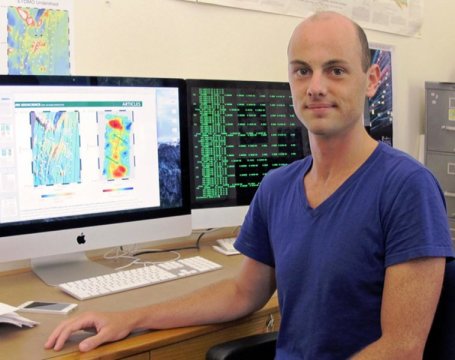
Brandon VanderBeek, a doctoral student at the University of Oregon, led a study that investigated interactions of the Earth’s mantle and tectonic plates off the coast of Washington state.Credit: University of Oregon
“Comparing seismic measurements of the present mantle flow direction to the recent movements of tectonic plates, we find that the mantle is flowing in a direction that is ahead of recent changes in plate motion,” said UO doctoral student Brandon P. VanderBeek, the paper’s lead author. “This contradicts the traditional view that plates move the mantle.”
While the new conclusion is based on a fraction of such sites under the world’s oceans, a consistent pattern was present, VanderBeek said. At the three sites, the mantle’s flow is rotated clockwise or counterclockwise rather than in the directions of the separating plates. The mantle’s flow, the researchers concluded, may be responsible for past and possibly current changes in plate motion.
The research — funded through National Science Foundation grants to the two institutions — also explored how the supply of magma varies under mid-ocean ridge volcanoes. The researchers conducted a seismic experiment to see how seismic waves moved through the shallow mantle below the Endeavor segment.
They found that the middle of the volcanic segment, where the seafloor is shallowest and the inferred volcanic activity greatest, the underlying mantle magma reservoir is relatively small. The ends, however, are much deeper with larger volumes of mantle magma pooling below them because there are no easy routes for it to travel through the material above it.
Traditional thinking had said there would be less magma under the deep ends of such segments, known as discontinuities.
“We found the opposite,” VanderBeek said. “The biggest volumes of magma that we believe we have found are located beneath the deepest portions of the ridges, at the segment ends. Under the shallow centers, there is much less melt, about half as much, at this particular ridge that we investigated.
“Our idea is that the ultimate control on where you have magma beneath these mountain ranges is where you can and cannot take it out,” he said. “At the ends, we think, the plate rips apart much more diffusely, so you are not creating pathways for magma to move, build mountains and allow for an eruption.”
WFS,World Fossil Societry,Riffin T Sajeev,Russel T Sajeev
WFS News : Heterodontosaurus tucki Fossil found in SA finally gives up its secrets
 July 28th, 2016
July 28th, 2016  Riffin
Riffin Johannesburg – A remarkable dinosaur fossil discovery made by a South African palaeontologist in 2005 has finally revealed its secrets.The fossil, the most complete ever found of a species known as Heterodontosaurus tucki, was recently scanned at the European Synchrotron Radiation Facility (ESRF) in Grenoble, France.
The Evolutionary Studies Institute at the University of the Witwatersrand (Wits) in Johannesburg took the complete skeleton of the small dinosaur to the ESRF. The dinosaur is believed to have roamed the earth 200 million years ago.Billy de Klerk found the fossil in a stream bed on a farm near Grahamstown in the Eastern Cape.
The dinosaur was scanned between July 21 and July 26.
“Heterodontosaurus was a small, plant-eating animal with grinding teeth in the back of the jaw and big canines in the front,” the ESRF’s spokesperson Delphine Chenevier said in a statement.
De Klerk excavated the fossil from the stream bed and removed enough rock from the bones to identify the animal. The skeleton was, however, too small and delicate, and the rocks around it too hard to enable scientists to fully study the anatomy. The fossil was therefore sent to the ESRF, where it was X-rayed.
“That’s where the synchrotron comes in: the high-energy X-rays generated… will allow scientists to reconstruct the skeleton in incredible detail,” said Chenevier.
A team of scientists, led by Wits Prof Jonah Choiniere, with the ESRF’s palaeontologist Dr Vincent Fernandez, scanned the specimen with high-powered X-rays. They wanted to understand how Heterodontosaurus ate, moved, and breathed.
“We think the back teeth are used for grinding,” Chenevier said.
“Typically, in dinosaurs that have grinding dentition, they have a certain type of tooth replacement, that is: teeth grow inside the jaw and gradually replace those grinding teeth as they wear down. Lots of scientists have speculated about tooth replacement in Heterodontosaurus. Now this is the first time that we have a complete jaw and we can actually test some of those speculations.”
Choiniere said the scans revealed details of the bones forming the roof of the mouth.
“We can see the palate and the mid-line of the skull and those palate bones are really very fine, less than 1mm across. We’ve scanned this at such a good resolution that we can actually see the outlines of the palate bones very, very well.”
Source:news24.com
Key: WFS,World Fossil Society,Riffin T Sajeev,Russel T Sajeev
WFS News : Aftermath of a mass extinction
 July 21st, 2016
July 21st, 2016  Riffin
Riffin A new study of fossil fishes from Middle Triassic sediments on the shores of Lake Lugano provides new insights into the recovery of biodiversity following the great mass extinction event at the Permo-Triassic boundary 240 million years ago.
The largest episode of mass extinction in the history of the Earth, which led to the demise of about 90% of marine organisms and a majority of terrestrial species, took place between the Late Permian and Early Triassic, around 240 million years ago. How long it took for biological communities to recover from such a catastrophic loss of biodiversity remains the subject of controversial debate among paleontologists. A new study of fossil fishes from Middle Triassic strata on the shores of Lake Lugano throws new light on the issue. The study, undertaken by researchers led by Dr. Adriana López-Arbarello, who is a member of the GeoBiocenter at LMU and the Bavarian State Collection for Paleontology and Geology, suggests that the process of recovery was well underway within a few million years. The authors, including Dr. Heinz Furrer of Zurich University and Dr. Rudolf Stockar of the Museo Cantonale di Storia Naturale in Lugano, who led the excavations at the sites, and Dr. Toni Bürgin of the Naturmuseum St. Gallen report their findings in the journal PeerJ.
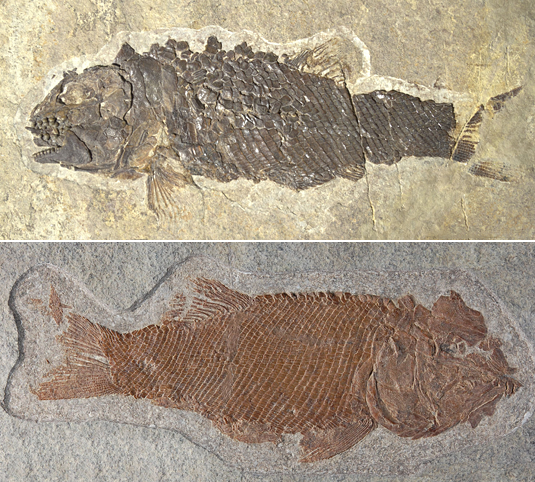
A specimen of the newly identified fossil species Ticinolepis crassidens (above) and of the species Ticinolepis longaeva. (Source: Adriana López-Arbarello)
The fossil fishes analyzed by López-Arbarello and her colleagues originate from Monte San Giorgio in the canton Ticino in Switzerland, which is one of the most important sources of marine fossils from the Middle Triassic in the world. The Monte San Giorgio rises to an altitude of 1000 m on the promontory that separates the southern arms of Lake Lugano in the Southern Swiss Alps. But in the Middle Triassic, it was part of a shallow basin dotted with islands fringed by lagoons, which were separated by reefs from the open sea. “The particular significance of its fossil fauna lies in the careful stratigraphic work that has accompanied the excavations here. The positions of each of the fossil finds discovered here have been documented to the centimeter,” says Adriana López-Arbarello. On the basis of detailed anatomical studies of new material and a taxonomic re-evaluation of previously known specimens from the locality, she and her colleagues have identified a new genus of fossil neopterygians, which they name Ticinolepis. The Neopterygii include the teleost fishes, which account for more than half of all extant vertebrate species. However, the new fossil species are assigned to the second major group of neopterygians, the Holostei, of which only a handful of species survives today. The researchers assign two new fossil species to the genus Ticinolepis, namely T. longaeva and T. crassidens, which occur in different sedimentary beds within the so-called Besano Formation on Monte San Giorgio.
The two species coexisted side by side but they occupied distinct ecological niches. T. crassidens fed on mollusks and was equipped with jaws and teeth that could handle their hard calcareous shells. T. longaeva was more of a generalist, and was found in waters in which T. crassidens could not survive. The authors interpret the different distribution patterns as a reflection of changing environmental conditions following the preceding mass extinction event. The less specialized T. longaeva was able to exploit a broader range of food items, and could thus adapt more flexibly to fluctuating conditions. On the other hand, the dietary differentiation between the two species indicates that a variety of well-established ecosystems was available in the Besano Formation at this time. “This in turn suggests that the marine biota is likely to have recovered from the great mass extinction relatively quickly,” Adriana López-Arbarello concludes. (PeerJ 2016)
Source:Ludwig-Maximilians-Universität München
@WFS,World Fossil Society,Riffin T Sajeev,Russel T Sajeev
WFS News: Newfoundland fossil trove named UNESCO World Heritage Site
 July 18th, 2016
July 18th, 2016  Riffin
Riffin @WFS,World Fossil Society,Riffin T Sajeev,Russel T Sajeev
MISTAKEN POINT, N.L. — A rocky stretch of coastline along the southeastern tip of Newfoundland that holds secrets about the origins of complex life has been declared a world heritage site by the United Nations Organization for Education, Science and Culture.
Mistaken Point, so-named for its frequent disorienting fog, is home to the oldest-known evidence of early multicellular creatures.
The 565-million-year-old sea floor is embedded with the remains of ancient fossils, slowly exposed by the pounding Atlantic surf. Preserved in time by repeated volcanic ash-falls, the fossils include some of the earliest animal-like creatures ever discovered — a rare glimpse into what it was like “when life got big.”
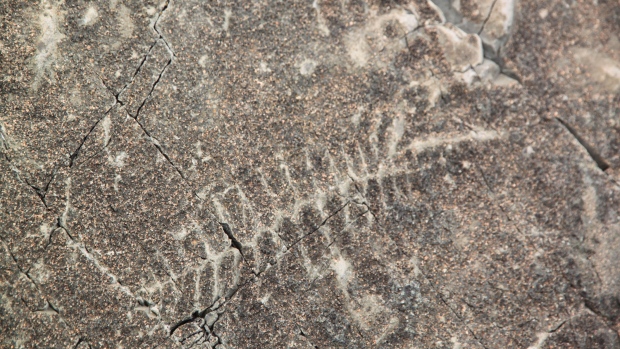
Outlines of fossils that have been scientifically dated back 565 million years are seen in this handout photo from Mistaken Point Ecological Reserve in N.L. on July 16, 2013. (HO, Mike Wert / THE CANADIAN PRESS)
The decision was announced in Istanbul after a hurried review by the UNESCO World Heritage Committee on Sunday. The annual meeting had been cut short by a coup attempt in Turkey less than 48 hours earlier, forcing the committee to fast-track its agenda.
More than 6,200 kilometres away, a small crowd gathered in the Edge of Avalon interpretive centre in Portugal Cove South, N.L. to watch a live online feed of the proceedings.
“Everybody was going crackers,” Richard Thomas, a geologist who led the province’s years-long effort. “I was just sitting there dazed … I thought this day would never come.”
The rural fishing town, around a two-hour drive south of St. John’s, erupted in celebration, car horns blaring in a motorcade with blue-and-white balloons in honour of the United Nations’ official colours.
“Our province’s natural heritage is recognized today on the international stage,” Environment Minister Perry Trimper said in a statement.
Of 1000-plus world heritage sites around the world, there are now 18 in Canada. This will be the fourth in Newfoundland and Labrador and the first to be managed by the province.
UNESCO’s website says the prestige of being declared a world heritage site often raises awareness of the importance of preservation and a country may also get financial assistance and expert advice from the World Heritage Committee to support preservation.
Another Canadian bid seeking UNESCO World Heritage Site status for Pimachiowin Aki, a large swath of boreal forest along the Manitoba-Ontario border, remains in limbo after the Pikangikum First Nation withdrew its support for the project over concerns about some Unesco reports of the area.
“We are all very disappointed that we encountered these challenges at such a critical time in the nomination process, after working on this project for 12 years,” William Young of the Pimachiowin Aki Corporation said in a statement. “We felt that we had no option but to seek a referral to give us all a chance to regroup and consider potential options.”
The World Heritage Committee “referred” the nomination giving stakeholders three years to resubmit their bid after more fact-finding.
WFS News: The Geological Society of America (GSA) 2016 Annual Meeting
 July 14th, 2016
July 14th, 2016  Riffin
Riffin The Geological Society of America (GSA) 2016 Annual Meeting
This year’s five prestigious Pardee Keynote Symposia will scrutinize:
• Subsurface energy systems, which account for 80% of total US energy needs—Colorado is ranked eighth among the states in proven oil reserves;
• The environmental impacts of hydraulic fracturing;
• Managing the high plains aquifer for future prosperity, with featured speaker Ann Castle;
• Geology of our solar system’s “third zone” — Pluto, Charon, and the Kuiper Belt;
• The geologic evolution of Cuba, featuring keynote speaker Manuel Antonio Iturralde Vinent in the first joint event in many years between the geological societies of our two nations, we initiate what we hope will become a strong relationship.
Sunday’s Presidential Address and Awards Ceremony will feature incoming GSA President Claudia Mora, Los Alamos National Laboratory, talking about mission-driven geoscience in federal agencies, working toward a goal of developing the basic understanding necessary to solve complex problems in support of the Nation’s energy and national security, and its environmental health. In addition, top honors will be awarded to luminaries in the field.
There are currently 230 topical sessions submitted, many of which are identified with icons denoting industry applicability—including Energy, Economic Geology, Hydrogeology, Environmental Geology, and Engineering Geology.
“Head to Denver for the annual GSA meeting and fall aspen display—they set the gold standard for leaf gazing and Earth Science,” says Meeting General Chair Karen Berry of the Colorado Geological Survey. Technical Program Chair Paul Baldauf, Nova Southeastern University Natural Sciences and Oceanography, invites participation, stating that the 2016 program “continues to demonstrate GSA’s relevance in the geoscience community with diverse and outstanding sessions.”
September meeting dates portend agreeable weather for the 35 pre- and post-meeting scientific field trips, which are a unique feature of GSA meetings. Several field trips will explore the stratigraphy of the Denver Basin and its prime unconventional reservoirs. One field trip will explore Denver’s energy grid and look at the role coal, gas, solar, wind, and other renewables play in keeping the lights on. Other field trips will explore the cultural history, legacy, and geology of Colorado’s gold and mineral belt. Members of the media must register and pay appropriate fees to participate.
Complete meeting information will be updated regularly on the Annual Meeting website. Information is also available in the June issue of GSA Today.
Oral Sessions run Sun.–Wed., 8 a.m.–5:30 p.m. at the Colorado Convention Center, 700 14th Street, in Denver. Watch the website for special “Feed Your Brain” lunchtime lectures scheduled each day from noon to 1:30 p.m.
Poster Sessions will be on display 9 a.m.–5:30 p.m. on Sun. with authors present from 3:30–5:30 p.m.,
Technical Program
Search topical sessions for areas of interest by discipline categories or sponsors from the drop-down menus, or use your browser’s “find” feature to search for keywords or convener names.
The complete technical program schedule will be available in early August 2016 after the abstract submission deadline.
WFS WISHES ALL SUCCESS to GSA 2016 Annual meeting And Sessions
@WFS,World Fossil Society,Riffin T Sajeev,Russel T Sajeev.
WFS News: Calciavis grandei, Ostrich relative lived in North America about 50 million years ago
 July 14th, 2016
July 14th, 2016  Riffin
Riffin Exceedingly well-preserved bird fossil specimens dating 50 million years represent a new species that is a previously unknown relative of the modern-day ostrich, according to a new paper co-authored by Sterling Nesbitt of Virginia Tech’s College of Science and part of the university’s Global Change Center.
The bird fossils were found more than a decade ago, completely intact with bones, feathers, and soft tissues in a former lake bed in Wyoming. Nesbitt cannot hide a grin as he calls the fossil a once-in-a-lifetime discovery for paleontologists.
“This is among one of the earliest well-represented bird species after the age of large dinosaurs,” said Nesbitt, an assistant professor in the Department of Geosciences.
“You can definitely appreciate how complete these fossil are,” added Nesbitt of the remains, the focus of a research paper co-authored by Nesbitt and newly published in the Bulletin of the American Museum of Natural History.
Some of the remains are now on display as part of the exhibit “Dinosaurs Among Us” at the New York-based history museum. The fossils Other specimens used in the study are kept by Chicago’s Field Museum of Natural History and the Wyoming Geological Survey.
The new species is named Calciavis grandei — with “calci” meaning “hard/stone,” and “avis” from the Latin for bird, and “grandei” in honor of famed paleontologist Lance Grande who has studied the fossil fish from the same ancient North American lake for decades.
The bird is believed to be roughly the size of a chicken, and similar to chickens, were mostly ground-dwelling, only flying in short bursts to escape predators.
Nesbitt began studying the fossil in 2009 whilst a postdoctoral researcher at the University of Texas at Austin’s Jackson School of Geosciences, under Professor Julia Clarke, whom Nesbitt considers an important mentor. Clarke co-authored the paper with Nesbitt, who joined Virginia Tech’s faculty in 2014.
The work was funded by two grants from the National Science Foundation’s Earth Sciences Directorate.
Two fossils of Calciavis dating from the Eocene epoch — roughly between 56 million and 30 million years ago — were found by fossil diggers within the Green River Formation in Wyoming, a hot bed for extinct fish. “These are spectacularly preserved fossils, one is a nearly complete skeleton covered with feather remains, the others are nearly are nearly as complete and some show soft tissue remains,” said Nesbitt.
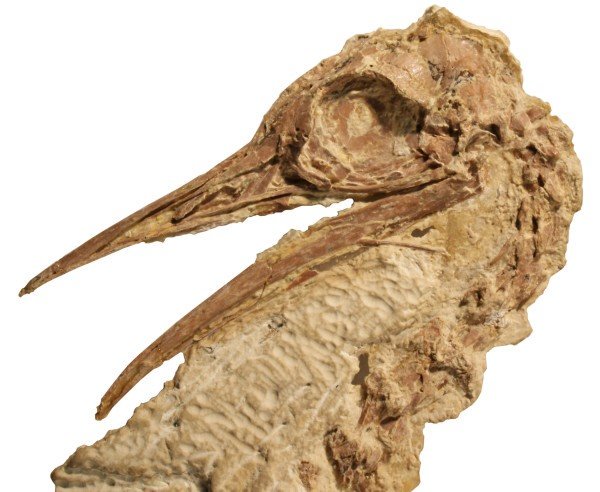
A Lithornithid skull from the Calciavis grandei fossil, found in Green River Formation of Wyoming.
Credit: Sterling Nesbitt/Virginia Tech
“Fossil birds are rare,” added Nesbitt, adding that as bird bones are hollow, they are far more fragile than most mammal bones, and more likely to be crushed during fossilization. One of the fossilized birds in this rare case apparently was covered in mud soon after death.
The former lake in which the fossil was found is best known for producing scores of complete fish skeleton fossils, but other fossils such as other birds, plants, crocodilians, turtles, bats, and mammals from an ecosystem roughly 50 million years old.
Included in the extinct group of early Palaeognathae birds, the Lithornithidae, Nesbitt and Clarke call the bird a close relative of living ostriches, kiwis, and tinamous now living in the southern continents. After tropical forests disappeared in North America, Calciavis and other more tropical birds went extinct, said Nesbitt and Clarke.
“Relationships among species in this lineage of birds have been extremely contentious,” said Clarke. “We hope the detailed new anatomical data we provide will aid finding a resolution to this ongoing debate.”
“The new bird shows us that the bird group that includes the largest flightless birds of today had a much wider distribution and longer evolutionary history in North America,” Nesbitt said. “Back when Calciavis was alive, it lived in a tropical environment that was rich with tropical life and this is in stark contrast to the high-desert environment in Wyoming today.”
The Calciavis skeleton will be important to interpreting new bird fossils and other fossils from the Eocene epoch that were collected decades ago. “This spectacular specimen could be a ‘keystone’ that helps interpret much of the sparse fossil of birds that once lived in North America millions of years ago,” said Nesbitt.
@WFS,World Fossil Society,Riffin T Sajeev,Russel T Sajeev,WFS News













